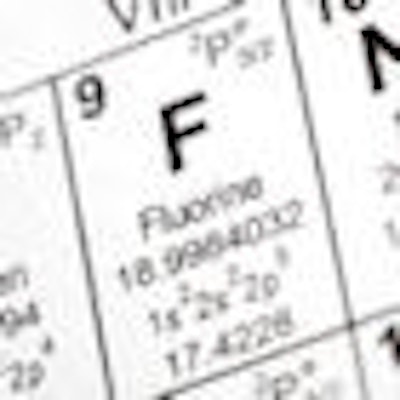
The effective delivery of fluoride to combat demineralization and caries was a common theme of several poster sessions at the International Association for Dental Research (IADR) meeting last week in Iguaçu Falls, Brazil.
In one study, researchers from the University of Copenhagen in Demark and the Karolinska Institutet and Public Dental Service in Sweden investigated how fluoridated milk affected enamel demineralization on teenagers wearing fixed orthodontic brackets. The results were promising, with the researchers concluding that "daily intake of fluoridated milk may counteract white-spot lesion development adjacent to fixed orthodontic appliances."
In the randomized controlled trial, 64 healthy 13- to 18-year-olds whose orthodontic treatment required fixed appliances were randomly split into two parallels groups. The test group drank 200 mL of milk supplemented that had 5 parts per million (ppm) of fluoride every day for 12 weeks while the control group drank nonfluoridated milk.
The study had an attrition rate of 13%. At the end of the trial, the participants were assessed with quantitative light-induced fluorescence for mineral gain or loss in enamel on two buccal sites. Fluorescence and the lesion area were compared with baseline readings from both groups.
The final evaluation included 112 sites. While there was no statistically significant difference in fluorescence values and lesion area between the groups at the beginning of the trial, "a significant decrease (p < 0.05) in fluorescence values was registered in the fluoridated milk group and a significant increase in the nonfluoride control group (p < 0.05)," the researchers wrote.
Additionally, "the mean reduction in the test group was somewhat lower (14%) than the increase in the control group (18%)," they added. The lesion area was minimally affected, and no statistically significant differences were observed when the results were compared with baseline readings.
Comparing flouride-releasing sealants
Fluoride delivery in the midst of orthodontic treatment was pivotal in another study, this one performed by Brazilian researchers at Lutheran University of Brazil in Canoas and Universidade Federal do Rio Grande do Sul in Porto Alegre.
The researchers compared the performance of two fluoride-releasing sealants, L.E.D. Pro Seal (LPS) by Reliance Orthodontic Products and Ortho-Coat (O-C) by Pulpdent, designed to inhibit enamel demineralization around brackets. While they found that LPS performed better, "both sealants were effective in reducing enamel demineralization adjacent to orthodontic brackets," they noted.
To compare the sealants, the researchers bonded orthodontic brackets to 60 bovine teeth and randomly assigned them to three different treatment groups: LPS, O-C, and no sealant for control. After being stored in artificial saliva, the teeth were "subjected to 96 hours of cariogenic challenge with acetic acid," the researchers wrote. Subsequently, the amount of enamel demineralization lesion depth was determined with the aid of polarized light microscopy. Imaging software helped the researchers determine the depth of the demineralized lesion in each tooth, and the results were compared using analysis of variance (ANOVA) and Tukey's post-hoc test (p ≤ 0.05).
Enamel surfaces treated with the two sealants displayed significant reductions in demineralization lesion depth compared with those of the control group (p ≤ 0.001). "O-C showed a 54.12% reduction, and LPS showed a 75.12% reduction when compared with controls," the researchers wrote. "LPS had the best performance, reducing lesion depth by 45.76% when compared with O-C."
Comparing flouride-releasing dentifrices
Another study, performed by researchers at Indiana Nanotech and funded by 3M ESPE, compared three products and their ability to inhibit white-spot lesion formation relative to a dentifrice without fluoride. It evaluated Clinpro 5000 (5,000 ppm of fluoride plus tricalcium phosphate) by 3M ESPE, Sensodyne Nupro 5000 (5,000 ppm of fluoride plus NovaMin) by Dentsply, and Renew (5,000 ppm of fluoride plus NovaMin) by Sultan Healthcare.
During the study, the researchers mounted polished bovine specimens on acrylic rods and divided them into four groups of eight. Fluoride-free Silly Strawberry toothpaste (Tom's of Maine) served as a control. Each group was immersed in artificial saliva with a pH of 7 and put through a daily routine of two one-minute treatments in a fourfold dilution with distilled water with a seven-hour acid challenge in between for 14 days. When the last routine was completed, the researchers took surface microhardness and fluoride uptake measurements on four of the specimens; the rest were analyzed for cross-sectional microhardness.
"No significant differences were observed among the three 5,000 ppm [fluoride] pastes within the subsurface enamel lesion; however, Clinpro 5000 produced superior lesion inhibition at the enamel surface and produced the greatest fluoride uptake relative to the other two 5,000 ppm [fluoride] pastes," the researchers wrote.
These results suggest Clinpro 5000 may provide additional protection against lesion formation relative to Sensodyne Nupro 5000 and Renew, they added.



















